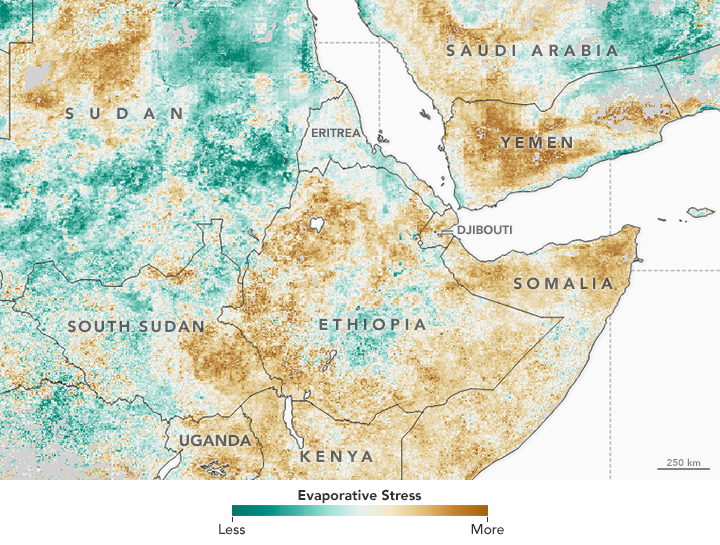


Political instability, war, and dry weather has pushed food production systems to the breaking point in several countries in the Greater Horn of Africa.
With tens of millions of people already facing serious food shortages in eastern Africa, aid organizations and governments warned in February 2017 that widespread famine could emerge in the coming months. Already, the United Nations has declared a famine in part of war-torn South Sudan. Somalia and Yemen—both wracked by civil war—are on the verge of famine as well.
While food shortages are relatively common in this part of the world, the formal declaration of famine is unusual. The technical definition requires that one in five households in a given area face extreme food shortages; that 30 percent of the population be malnourished; and that the death rate exceed 2 people per 10,000 per day.
Human conflict has triggered the worst food shortages, but drought has exacerbated the problem. In 2016, many parts of the Horn of Africa saw two consecutive wet seasons with poor rainfall. For instance, much of southern Somalia received less than 40 percent of the usual rainfall in October through December, according to the Famine Early Warning Systems Network (FEWS NET). Some major crop-producing regions faced their driest calendar year since 1985. With forecasters calling for depressed rainfall in the upcoming March-May rainy season, farmers and livestock herders in the region will likely face more crop failures and starving livestock.
The map above depicts the extent of drought conditions for a 12-week period ending on February 15, 2017. Areas with the highest degree of evaporative stress are shown in brown. The Evaporative Stress Index (ESI) is an indicator based on observations of land surface temperatures and leaf area index from the Moderate Resolution Imaging Spectroradiometer (MODIS) on NASA’s Terra and Aqua satellites and the Visible Infrared Imaging Radiometer Suite (VIIRS) on Suomi NPP. The combination makes it possible to gauge evapotranspiration—how much water is evaporating from the land surface and from the leaves of plants. Measuring evapotranspiration is useful because unusually low evapotranspiration is an early indicator that plants are facing stress, even if the leaves have not wilted or turned brown.
The current drought is tied to the weak La Niña conditions that emerged in the Pacific in 2016. La Niña shifts ocean temperatures and air pressure over the Pacific Ocean, with effects that ripple through weather patterns around the world. One of those effects is a reduction in rainfall in East Africa. The influence of La Niña was likely amplified by patches of unusually cool water in the western Indian Ocean and unusually warm water in the eastern part of the basin. This configuration—what meteorologists call the positive phase of the Indian Ocean Dipole—reduces rains in East Africa and increases them in Malaysia.
Anticipating and responding to food shortages in the Greater Horn of Africa poses a challenge because tracking where conditions are the most severe and distributing aid can be a slow, cumbersome process. Early warning crop analysis tools from the Group on Earth Observations, an international group funded by several G-20 countries, offers some shortcuts. The group’s GEOGLAM initiative produces early warning crop monitor reports that indicates countries and regions that could face food shortages.
In their February 2017 report, GEO warned of failing crops in northeastern Ethiopia, southeastern Somalia, and southeastern Kenya. The failures were particularly severe in southern Somalia, where harvests were expected to be 60 percent below normal in the main cereal-producing regions.
In more politically stable countries such as Djibouti, Ethiopia, Eritrea, Kenya, Sudan, and Uganda, drought has strained food systems. “But famine will not happen in places with working governments and functioning local economies,” explained Molly Brown, a University of Maryland scientist who works with FEWS NET. “In 2017, famine is an entirely man-made event. Effective government response with food and income safety nets is the difference between a crisis and just yet another La Niña-related drought.”
NASA Earth Observatory map by Joshua Stevens, using ESI data courtesy of Christopher Hain/NASA MSFC and the USDA Hydrology and Remote Sensing Lab. Caption by Adam Voiland.